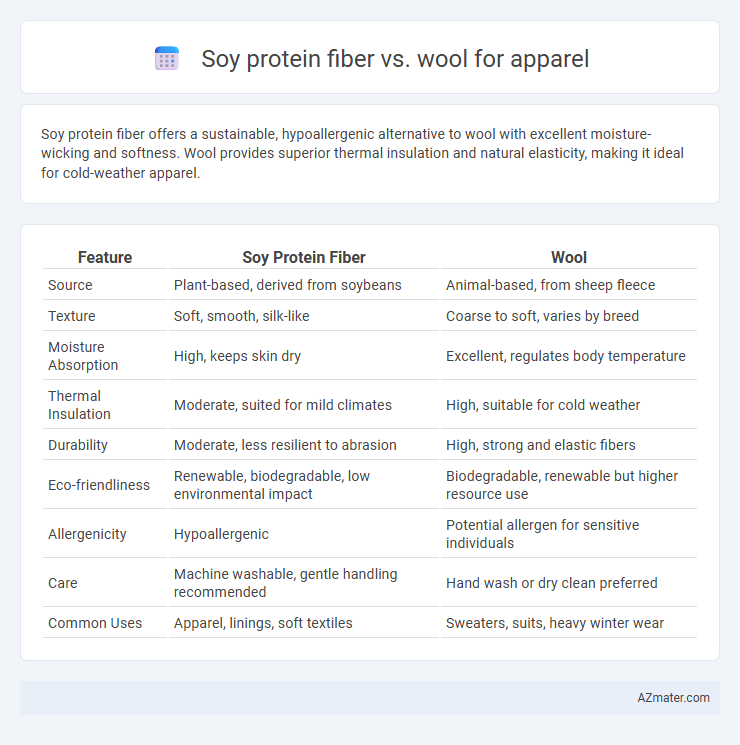Soy protein fiber offers a sustainable, hypoallergenic alternative to wool with excellent moisture-wicking and softness. Wool provides superior thermal insulation and natural elasticity, making it ideal for cold-weather apparel.
Table of Comparison
| Feature | Soy Protein Fiber | Wool |
|---|---|---|
| Source | Plant-based, derived from soybeans | Animal-based, from sheep fleece |
| Texture | Soft, smooth, silk-like | Coarse to soft, varies by breed |
| Moisture Absorption | High, keeps skin dry | Excellent, regulates body temperature |
| Thermal Insulation | Moderate, suited for mild climates | High, suitable for cold weather |
| Durability | Moderate, less resilient to abrasion | High, strong and elastic fibers |
| Eco-friendliness | Renewable, biodegradable, low environmental impact | Biodegradable, renewable but higher resource use |
| Allergenicity | Hypoallergenic | Potential allergen for sensitive individuals |
| Care | Machine washable, gentle handling recommended | Hand wash or dry clean preferred |
| Common Uses | Apparel, linings, soft textiles | Sweaters, suits, heavy winter wear |
Introduction to Soy Protein Fiber and Wool
Soy protein fiber, derived from soybean proteins, offers a sustainable and biodegradable alternative to traditional fibers with natural moisture-wicking and softness properties, making it ideal for comfortable apparel. Wool, sourced from sheep fleece, is renowned for its insulation, elasticity, and durability, providing excellent warmth and resilience in various garments. Both fibers contribute distinct performance benefits, with soy protein fiber emphasizing eco-friendliness and silkiness, while wool excels in thermal regulation and robustness.
Origins and Production Processes
Soy protein fiber, derived from defatted soybeans, undergoes a wet spinning process where soy protein is regenerated into fiber form, making it a sustainable byproduct of soybean oil production. Wool originates from the fleece of sheep, primarily produced through shearing, followed by cleaning, carding, and spinning to create yarn. The soy protein fiber production emphasizes renewable plant-based resources and lower environmental impact, while wool relies on animal agriculture with intricate animal welfare and land use considerations.
Environmental Impact and Sustainability
Soy protein fiber offers a sustainable alternative to wool by utilizing renewable soybeans, reducing reliance on animal agriculture and its associated greenhouse gas emissions. Wool production involves livestock farming, contributing significantly to methane emissions and land degradation, whereas soy protein fiber manufacturing generally has a lower carbon footprint and uses less water. Both materials support biodegradability, but soy protein fiber's plant-based origin aligns better with circular fashion goals and resource-efficient textile production.
Fiber Structure and Composition
Soy protein fiber is a regenerated protein fiber derived from soybean proteins with a smooth, round cross-section and a semi-crystalline structure that provides softness and moisture absorption. Wool consists of natural animal keratin fibers characterized by a scaly cuticle and a complex, amorphous cortex, delivering elasticity, thermal insulation, and breathability. The fundamental difference in fiber composition--plant-based protein versus animal keratin--results in distinct tactile properties and performance in apparel applications.
Comfort and Moisture Management
Soy protein fiber offers superior softness and a smooth texture compared to wool, enhancing overall comfort in apparel. It exhibits excellent moisture-wicking properties, efficiently drawing sweat away from the skin to keep the wearer dry and cool. Wool naturally regulates temperature and provides warmth but tends to retain moisture longer, which can lead to dampness and reduced comfort during intense activities.
Thermal Insulation Properties
Soy protein fiber offers excellent thermal insulation due to its natural micro-hollow structure, which traps air and retains body heat efficiently. Wool, renowned for its superior insulation, contains crimped fibers that create air pockets, enhancing warmth even in damp conditions. While wool outperforms soy protein fiber in moisture-wicking and temperature regulation, soy protein fiber provides a sustainable and hypoallergenic alternative with competitive insulating properties for apparel applications.
Durability and Longevity
Soy protein fiber exhibits moderate durability, offering a soft texture but tends to weaken with prolonged exposure to moisture and UV light. Wool is highly durable and resilient, maintaining its structure and insulating properties over time even with frequent wear and washing. Wool's natural elasticity and moisture-wicking capabilities contribute significantly to its superior longevity compared to soy protein fiber in apparel applications.
Dyeability and Color Retention
Soy protein fiber exhibits excellent dyeability due to its amino acid structure, allowing for vibrant and diverse color options with strong affinity to reactive and acid dyes. Wool, composed primarily of keratin, similarly offers superior dye uptake and colorfastness, particularly with acid dyes, resulting in rich, deep hues that resist fading over time. In terms of color retention, wool maintains its vibrancy longer under exposure to light and washing, while soy protein fiber, though effectively dyed, may experience moderate fading with prolonged environmental stress.
Allergenicity and Skin Sensitivity
Soy protein fiber exhibits hypoallergenic properties and is often preferred for sensitive skin due to its smooth texture and moisture-wicking abilities, reducing irritation risk. Wool, while naturally insulating and breathable, can trigger allergic reactions or itching in individuals with sensitive skin because of its lanolin content and coarse fibers. Choosing soy protein fiber over wool can benefit those prone to skin allergies or sensitivities, promoting enhanced comfort in apparel.
Price and Market Availability
Soy protein fiber offers a cost-effective alternative to wool, often priced lower due to its plant-based origin and simpler manufacturing process. Wool remains a premium textile with higher market availability driven by established supply chains and demand for its natural insulation properties. Availability of soy protein fiber is expanding in sustainable fashion sectors, though it still lags behind wool's widespread presence in mainstream apparel markets.

Infographic: Soy protein fiber vs Wool for Apparel
 azmater.com
azmater.com